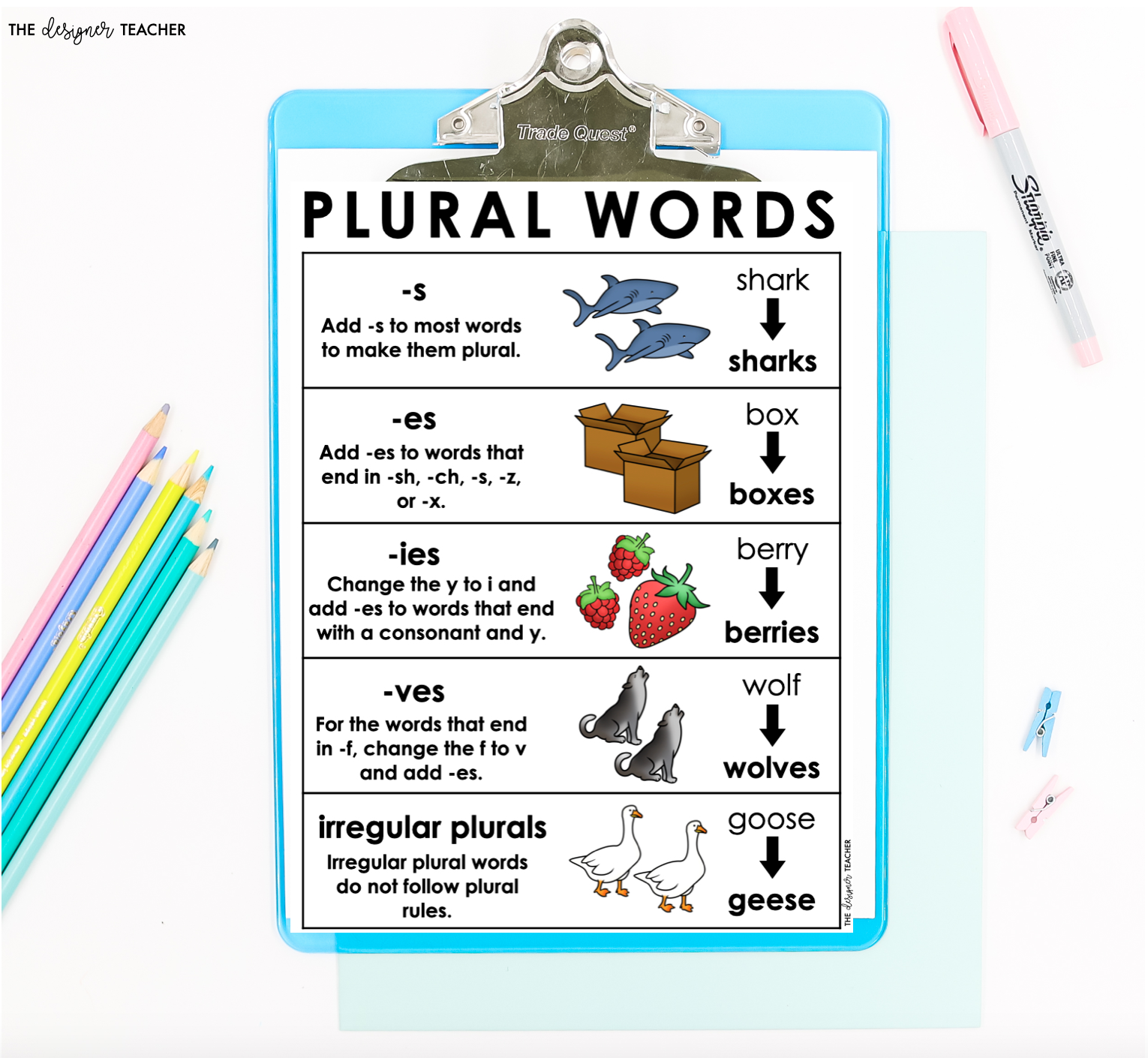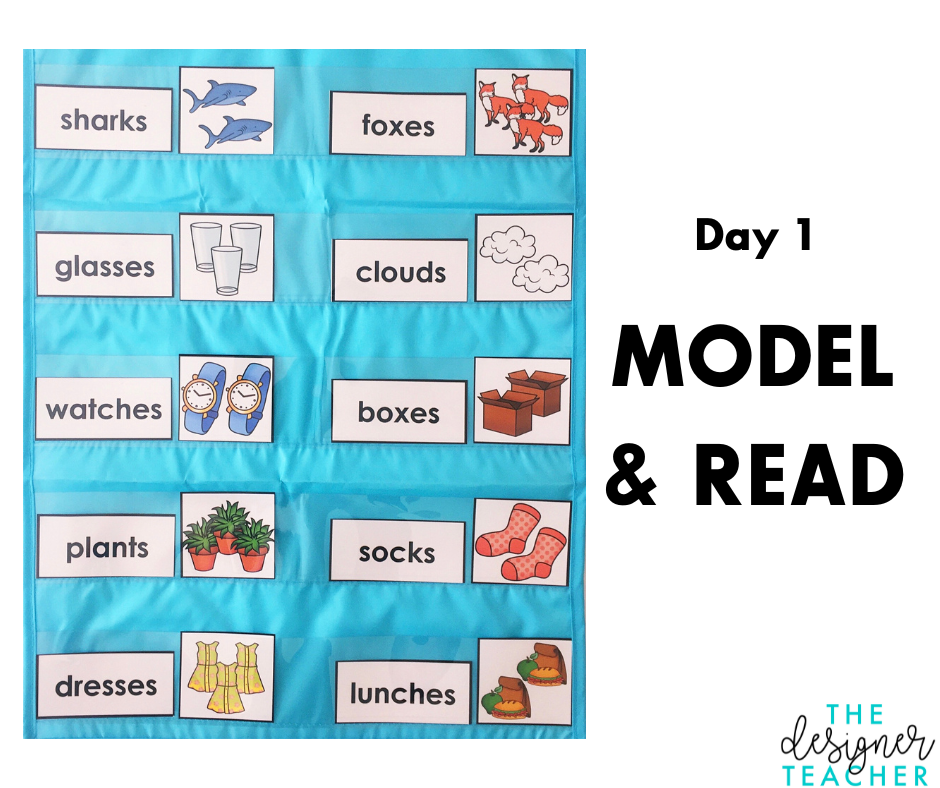How to Teach Plural Nouns
The most common way to make a noun plural is to add the letter S, and many students are easily able to read and write plural words with S, such as “cats.” However, there are several other forms of plural nouns, and these require explicit instruction. In this blog post, I’ll first go over the rules for these different forms of plural nouns, and then provide a sample lesson plan for how to teach -S and -ES over the course of a week.
Plural Rules
-S: Adding -S is the default for making most words plural. For example, the plural of “shark” is “sharks.”
-ES: For words that end in -SH, -CH, -S, -X, or -Z, add-ES instead of just -S to make the word plural. For example, the plural form of “box” is “boxes.”
-IES: For words that end in a consonant and then y, change the Y to I and add -ES. For example, the plural form of “berry” is “berries”, because berry ends in a consonant and then y. Make sure students know you do not use IES for all words that end in Y– only words that have a consonant before the Y. For example, the plural of monkey is monkeys, not monkies.
-VES: For words that end in F, change the F to V and -ES. for example, the plural form of “leaf” is “leaves.”
Irregular: Some words do not follow any of the above words and instead of unique plural forms. These words include geese, children, men, and women.
Grab this FREE poster explaining all the plural rules by signing up for The Designer Teacher mailing list below!
As a special education teacher, I find that introducing one or two of these concepts a week works well. If you’re teaching general education, you may find that you’re able to progress more quickly. I follow the same general lesson plan for each week, which is easier for both you and your students. In this post, I’ll use -S and -ES for the examples and explain how I teach plural words with -S and -ES over the course of one week. You can follow the same structure when teaching the other plural rules.
Sample Lesson Plan
Day 1
Explain to students that this week, they’ll be learning how to read and spell words that are plural, meaning more than one. Explain that for most words, the letter -S is used at the end to make it plural. Show or write the word “plants” and point out the -S at the end. Sound it out (/p/ /l/ /a/ /n/ /t/ /s/) and note that it means more than one plant. Now explain that when a word ends in -SH, CH, -S,-X, or -Z, we use -ES to make it plural. Show or write the word “lunches” and point out the -ES at the end, and read it aloud. After modeling, lead students in guided practice of reading more plural words with -S and -ES. Then, practice reading fluency sentences together that plural words. You can find the needed picture cards, word cards, and fluency sentences in my Phonics by Design Plural Words Unit.
Day 2
Briefly review what you taught yesterday, and then tell students they’ll be practicing writing plural words with -S and -ES today. Show a picture card of “dresses” or another plural noun ending in -S. Note that there is more than one dress, so you know you will need to make it plural. Sound out the word (/d/ /r/ /e/ /s/) and note that it ends in S, so you know you will need to use -ES. Write the word “dresses” on the board or chart paper. Continue with other picture cards, using plural nouns that end in both -S and -ES Finally, have students practice on their own by dictating words to them and having them write them down. You can also dictate a few short sentences that include plural nouns.
Day 3
Today students will independently practice reading and writing plural words with -S and -ES. I use the activity sheets included in my Phonics by Design Plural Words Unit and in my No Prep Pack.
Day 4
Review reading and spelling words with -S and -ES before introducing a simple plural word matching game they can play in pairs. Spread out the cards in a grid face down. When it’s their turn, the student will turn over two cards and identify the pictures and/or read the words. If it’s a match, they keep the pair. If not, they put the cards back, face down. Students alternate turns until all pairs have been matched. The student with the most pairs wins. You can find plural word matching games in my Phonics by Design Plural Words Unit.
Day 5
Assess students by dictating ten plural words with -S and -ES and having them record them. If you have time and a small enough group, you may also wish to have individual students read a few plural words as well
This lesson plan schedule for teaching plural words is simple but effective! I usually start with -S and -ES, and then -IES, then -VES, and finally irregular plurals.
Save yourself time by snagging everything you need to teach plural words in one place with my Phonics by Design Plural Words Unit Bundle. You’ll get all the materials mentioned in this post for each plural word type (picture cards, word cards, fluency sentences, activity sheets, matching game), plus posters, flapbooks, and more! Get it here.
And don’t forget to grab your FREE plural word types poster by signing up for The Designer Teacher mailing list below!
No time to read now?








